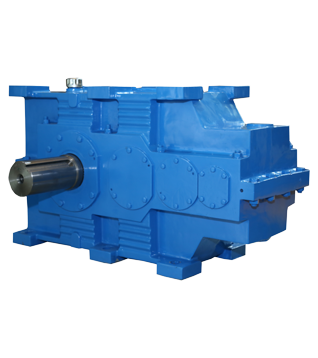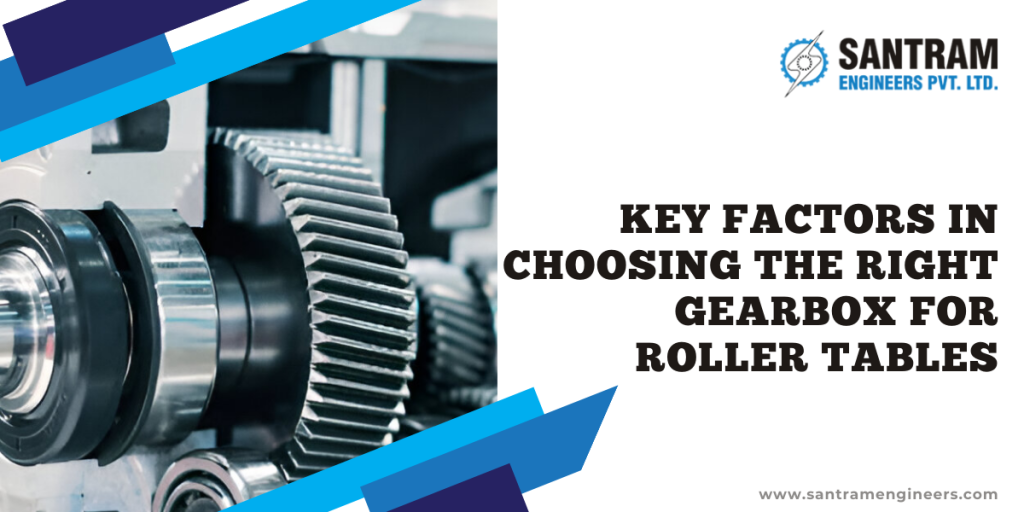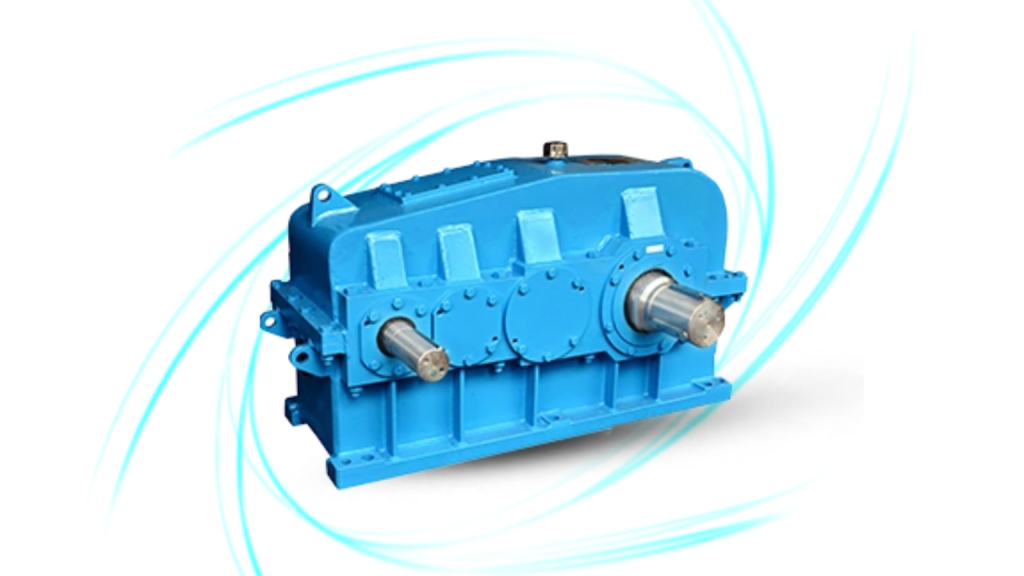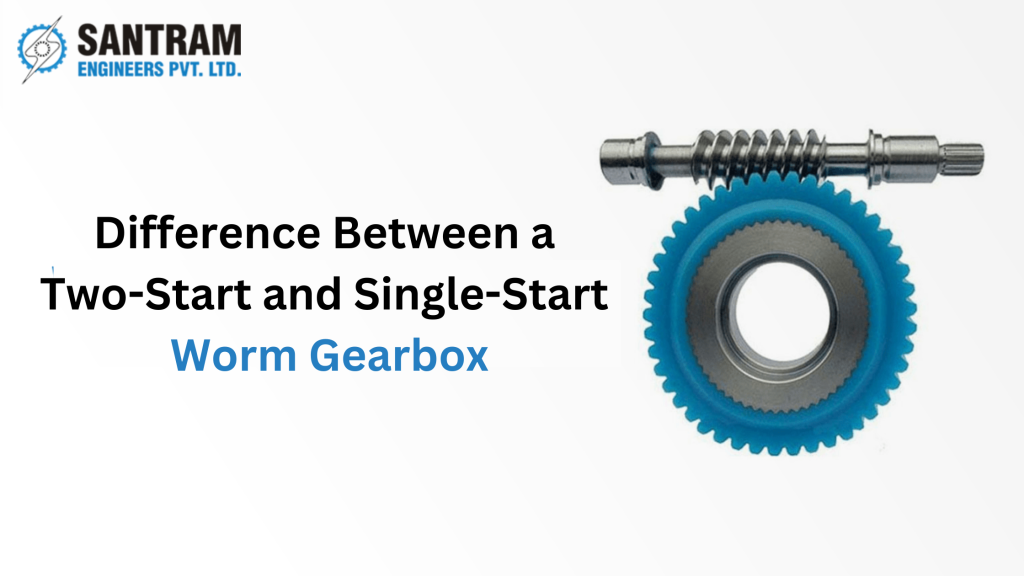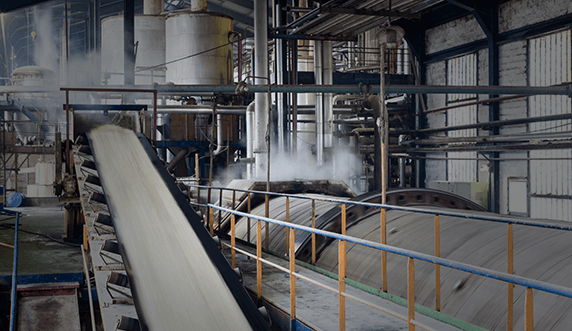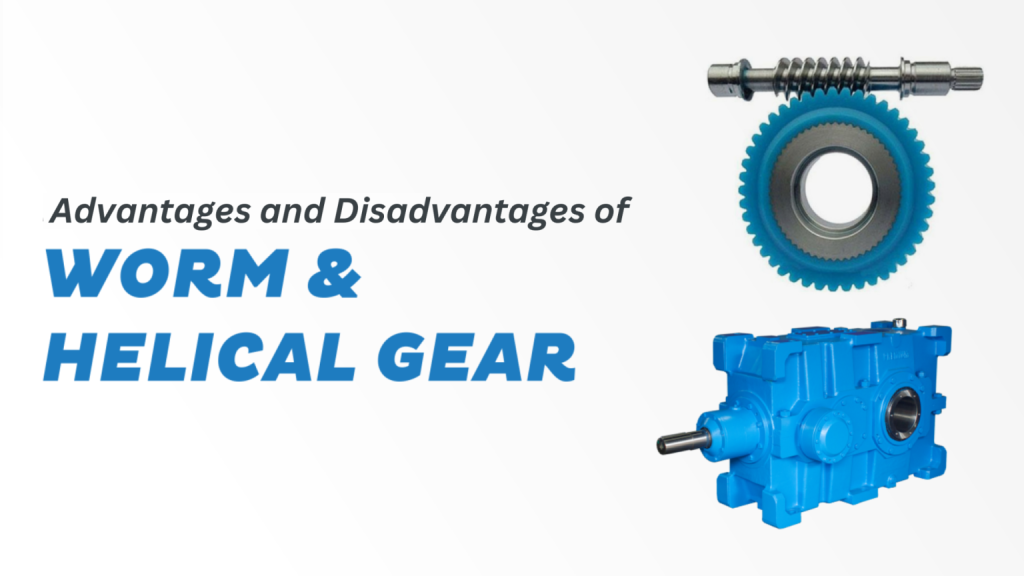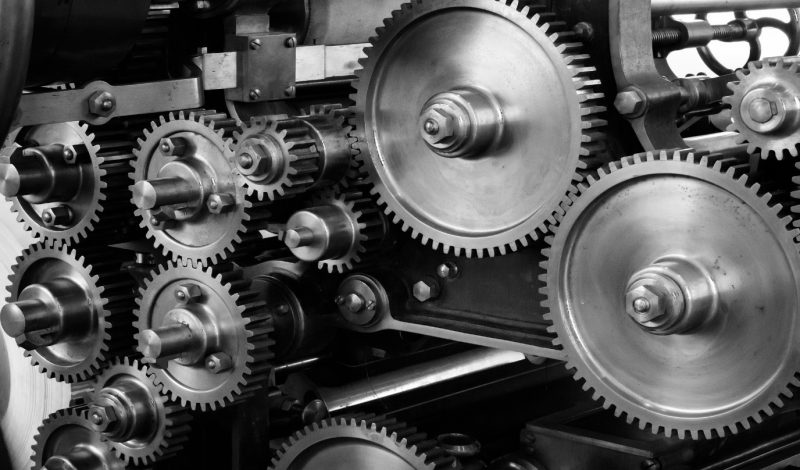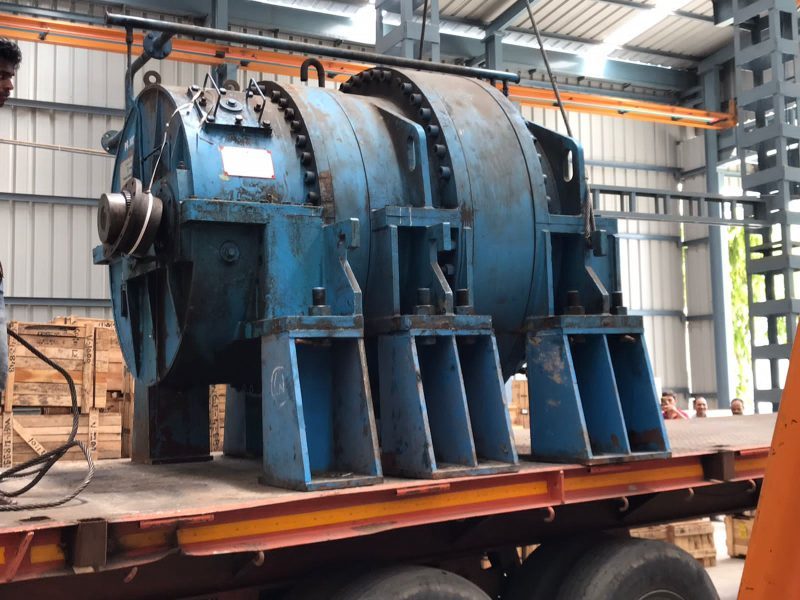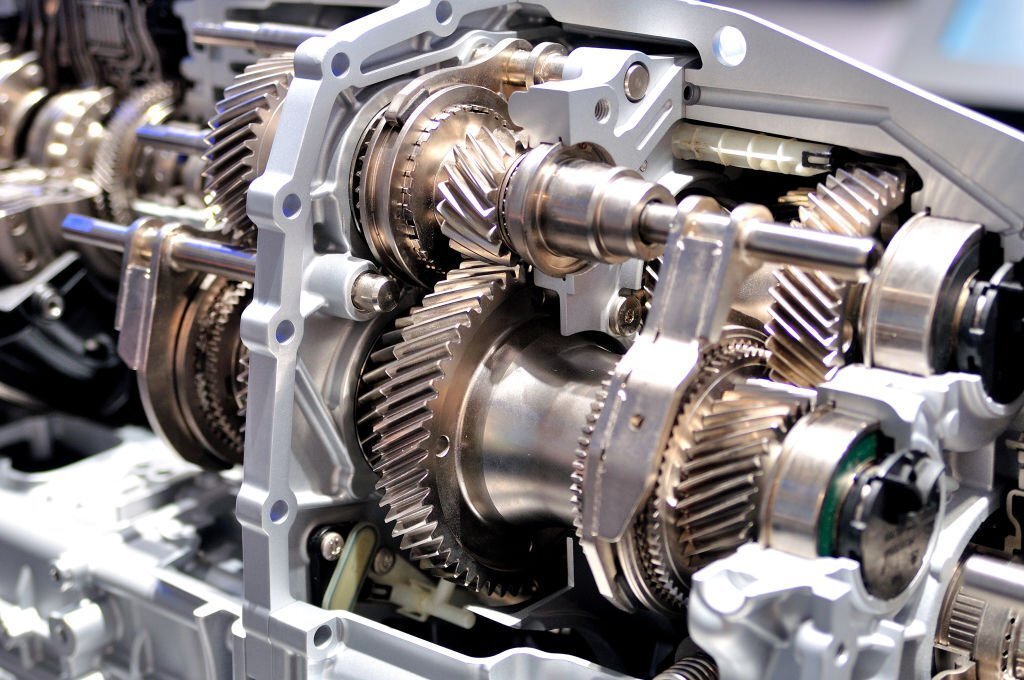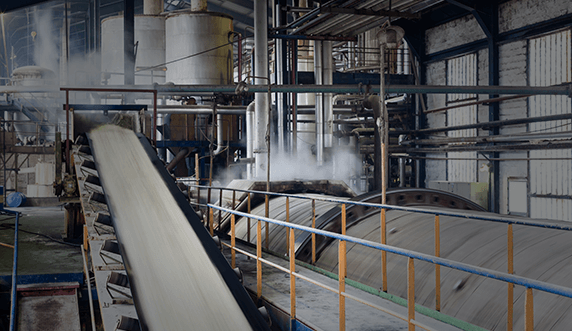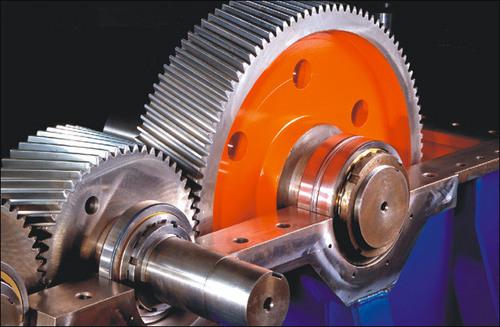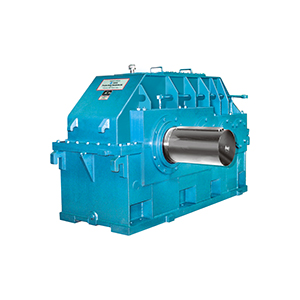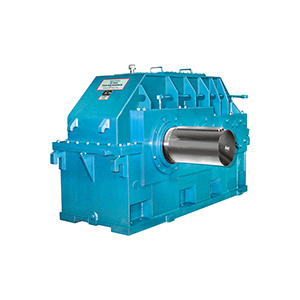For your application in helical gearboxes, the choice between single and double helical gears plays a pivotal role in determining the performance, efficiency, and durability of the gearbox.
In this article, we delve into the basics of helical gears, exploring the characteristics that set them apart, and then break down the specifics of single and double helical gears, aiding businesses in making informed decisions when it comes to selection.
Basics of Helical Gears
Helical gears are characterized by their teeth, which are cut at an angle to the gear axis, forming a helix. To form a helical gearbox, multiple helical gears are arranged in a specific configuration. This arrangement introduces a smooth and gradual engagement of the gears, resulting in reduced noise and vibration compared to other gear types.
The helix angle, an essential parameter in helical gears, refers to the angle between the gear’s tooth and an imaginary line perpendicular to the gear axis. The helix angle influences the gear’s performance, affecting factors such as load-carrying capacity, efficiency, and smoothness of operation. Generally, a higher helix angle results in quieter operation but may sacrifice some load-bearing capacity.
These characteristics make them well-suited for various helical gearbox applications, especially those requiring precision and reliability, such as in industrial machinery, automotive transmissions, and power generation systems.
Single Helical Gear
Construction and Design:
Single helical gears, also known as “spur gears with a twist,” have teeth cut at an angle to the gear axis, forming a continuous helix along the gear face. The construction involves a single helix angle for the entire gear.
Advantages:
- Quiet Operation: Single helical gears provide smoother and quieter operation due to the gradual engagement of the teeth.
- Higher Load-Carrying Capacity: The helical design allows larger contact areas between teeth, distributing the load more evenly and increasing the gear’s load-carrying capacity.
- Efficiency: They offer higher efficiency than other gear types, as the gradual engagement reduces impact forces and minimizes wear and tear.
- Compact Design: They can be more compact than other gear types, making them suitable for applications with space constraints.
Drawbacks:
- Axial Thrust: A significant limitation of single helical gears is the generation of axial thrust forces. This requires additional measures, such as thrust bearings, to counteract the axial forces and maintain proper gear alignment.
- Efficiency Loss in Crossed Helical Gears: In cases where gears are not parallel but instead at an angle to each other (crossed helical gears), there can be a reduction in efficiency due to increased sliding between the teeth.
Double Helical Gears
Construction and Design:
Double helical gears, or herringbone gears, incorporate two sets of teeth that are helically arranged but with opposite hands, resembling the letter “V” or a herringbone pattern. This design eliminates axial thrust forces, a key advantage over single helical gears.
Advantages:
- Reduced Vibration and Noise: Canceling axial thrust forces reduces vibration and noise levels, making double helical gears ideal for applications where quiet operation is essential.
- Enhanced Stability: The opposing helix angles enhance the stability of the gear system, minimizing the risk of misalignment and improving overall performance.
- Higher Efficiency in Crossed Helical Gears: Unlike single helical gears, crossed double counterparts can maintain high efficiency even when the gears are not parallel, making them suitable for a broader range of applications.
Drawbacks:
- Increased complexity: Double helical gears are more intricate in design than single helical gears, leading to higher manufacturing and maintenance costs.
- Axial thrust: They generate axial thrust, requiring additional thrust bearings to counteract the resulting forces, unlike single helical gears that exhibit lower axial loads.
- Lubrication challenges: The double helix design may pose challenges in ensuring effective lubrication across the gear teeth, leading to potential wear and tear issues.
- Limited applications: They are more suitable for specific applications, limiting their versatility compared to the more commonly used single helical gears.
Comparative Analysis
In the world of helical gearboxes, choosing between single and double helical gears involves carefully considering various factors to meet specific engineering challenges. Here, we present a comparison, shedding light on how each type addresses crucial considerations such as noise, load distribution, and efficiency.
| Criteria | Single Helical Gears | Double Helical Gears |
| Axial Thrust | The presence of axial thrust forces requires additional measures like thrust bearings to counteract. | Axial thrust forces are eliminated due to the opposing helix angles, ensuring a more stable gear system. |
| Noise and Vibration | Generally quieter compared to spur gears but may exhibit some noise, especially in crossed helical configurations. | Significantly reduced noise and vibration due to the cancellation of axial thrust forces, making them ideal for noise-sensitive applications. |
| Load Distribution | Larger contact areas between teeth, distributing the load more evenly and increasing load-carrying capacity. | The herringbone pattern increases the contact ratio, enhancing load distribution and capacity. |
| Efficiency | Offers high efficiency, especially in parallel gear configurations. Efficiency may reduce in crossed helical structures due to increased sliding. | Maintains high efficiency even in crossed helical configurations, making them versatile for various applications. |
| Manufacturing Complexity | Relatively simpler construction, making them more cost-effective to manufacture. | More complex to manufacture due to the intricate herringbone design, potentially leading to higher manufacturing costs. |
| Space Constraints | More compact design, suitable for applications with limited space. | May require slightly more space due to the herringbone design, making them less suitable for highly tight spaces. |
Applications
Understanding the real-world applications where single and double helical gears excel is crucial for businesses seeking optimal performance from their helical gearboxes. The choice between these two types depends on the specific requirements of a system, ranging from load capacity to noise considerations. Let’s explore the applications where each type shines.
Single Helical Gears
- Industrial Machinery: Single helical gears find extensive use in various industrial machinery applications, where their compact design, high efficiency, and smooth operation contribute to the overall performance of the system.
- Automotive Transmissions: The efficiency and load-carrying capacity of single helical gears make them suitable for automotive transmissions. Their ability to transmit higher torque ensures reliable and durable performance in the demanding conditions of vehicular applications.
- Power Generation Systems: In power generation systems, especially those requiring precision and reliability, single helical gears play a crucial role. Their smooth engagement and ability to handle substantial loads make them an ideal choice for generators and turbines.
- Oil and Gas Industry: Single helical gears are well-suited for various applications in the oil and gas industry, including pumps and compressors. Their efficiency and ability to withstand heavy loads make them reliable components in this demanding sector.
- Mining Equipment: The robust construction and load-carrying capacity of single helical gears make them suitable for heavy-duty mining equipment. Their ability to handle the challenging conditions of mining operations contributes to the longevity of the equipment.
Double Helical Gears
- High-Precision Machinery: Double helical gears, with their elimination of axial thrust forces and reduced noise levels, are preferred in high-precision machinery where quiet operation is paramount. Examples include helical gearboxes used in medical equipment and laboratory instruments.
- Aerospace Applications: The aerospace industry demands components that deliver exceptional performance with minimal noise. Double helical gears, with their superior stability and reduced vibration, are employed in critical aerospace applications, including aircraft engines.
- Power Plants: Double helical gears are favored in power plants, particularly when noise reduction is crucial. The cancellation of axial thrust forces and reduced vibration make them an excellent choice for power generation systems requiring a quiet and reliable operation.
- Marine Propulsion Systems: The robustness and stability of double helical gears make them suitable for marine propulsion systems. Canceling axial thrust forces ensures smoother operation, contributing to the efficiency and longevity of the propulsion system.
- Heavy-Duty Gearboxes: Applications that involve extremely heavy loads and stringent noise requirements, such as large-scale industrial gearboxes, often benefit from the characteristics of double helical gears. The enhanced load distribution and stability make them a preferred choice in such scenarios.
System-Specific Considerations
- Load Capacity: The load-carrying capacity of the gear system is a critical consideration. Single helical gears excel in applications where high efficiency and compact design are essential, while double helical counterparts shine in situations demanding superior load distribution and stability.
- Noise Requirements: For applications where noise reduction is a priority, such as in laboratories, hospitals, or aerospace environments, the superior noise reduction capabilities of double helical gears make them the preferred choice.
- Space Constraints: In applications with limited space, single helical gears may be favoured due to their more compact design. However, if space constraints allow, double helical gears can offer additional load distribution and stability benefits.
- Application Complexity: The complexity of the application and the precision required can influence the gear choice. Single helical gears, with their simpler design, may be suitable for straightforward applications, while the intricacies of double helical gears are advantageous in high-precision and critical applications.
One-Stop Destination for High-Performing Industrial Gearboxes
Transform your machinery’s performance with our unparalleled helical gearboxes. Santram Engineers offers a range of high-quality industrial gearboxes that are precision-engineered by Premium Transmission, an industry-leading brand known for delivering exceptional performance and unmatched reliability.
Whether you need a gearbox for a heavy-duty application or a specialized task, Santram Engineers has got you covered with their top-of-the-line selection of gearboxes designed to meet your unique needs and requirements.
Elevate your operational efficiency with gearboxes crafted for peak performance. Upgrade your machinery seamlessly with our finest helical gearboxes in the industry.
Make the smart choice, and let our industrial gearboxes drive your success. Contact us at +91 96247 39393 or email us at sales@santramengineers.com for gear solutions that stand the test of time.

